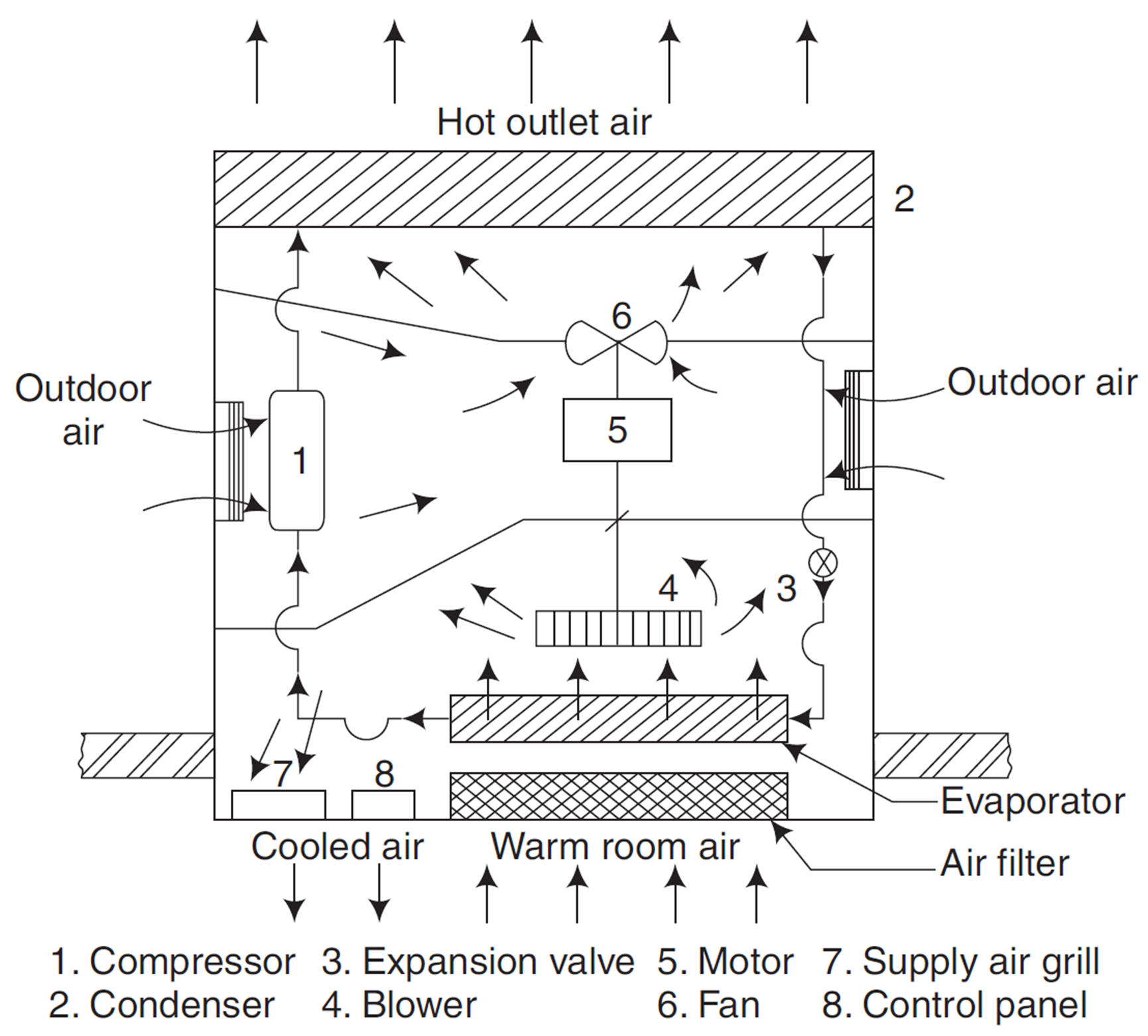A window air conditioner is a compact, self-contained air conditioning unit designed to be installed in a window or a specially designed slot in a wall. It is primarily used for cooling a single room and is one of the most common types of air conditioning systems in residential and commercial applications.

Figure 1: Window Air Conditioner.
Parts of a Window Air Conditioner
- Compressor: Located in the outdoor section, it compresses the refrigerant and circulates it through the system.
- Condenser: A heat exchanger that cools and condenses the refrigerant by releasing heat to the outside air.
- Expansion Valve: Regulates the flow of refrigerant from the high-pressure side to the low-pressure side.
- Blower: Draws warm indoor air and passes it over the evaporator coil for cooling before recirculating it into the room.
- Motor: Powers the blower and the fan, ensuring air movement within the system.
- Fan: Helps in heat dissipation by moving air over the condenser coils.
- Supply Air Grill: Directs the cooled air into the room efficiently.
- Control Panel: Allows users to set the desired temperature and fan speed.
- Evaporator Coil: Absorbs heat from the indoor air, cooling it down.
- Air Filter: Captures dust and other particles to ensure clean airflow.
Working Principle of a Window Air Conditioner
A window air conditioner operates on the basic refrigeration cycle, which involves the following steps:
- Compression: The compressor compresses the low-pressure refrigerant gas into a high-pressure, high-temperature gas.
- Condensation: The high-pressure gas moves to the condenser, where it dissipates heat to the outside air and condenses into a high-pressure liquid.
- Expansion: The high-pressure liquid passes through the expansion valve, where it expands and becomes a low-pressure, low-temperature liquid.
- Evaporation: The low-pressure liquid absorbs heat from the indoor air in the evaporator, cooling the air before being circulated back into the room. The refrigerant then evaporates into a low-pressure gas and returns to the compressor to repeat the cycle.
Types of Window Air Conditioners
| Type | Description |
|---|---|
| Fixed Window AC | Permanently installed, designed for fixed window openings. |
| Sliding Window AC | Designed for sliding windows, providing easy installation and removal. |
| Casement Window AC | Suitable for vertically opening windows, offering a narrow design. |
| Smart Window AC | Comes with Wi-Fi connectivity and smart controls for remote operation. |
| Portable Window AC | Hybrid model that can be moved and installed in different windows as needed. |
| Heat and Cool Window AC | Provides both cooling and heating functions for year-round comfort. |
Advantages of a Window Air Conditioner
- Affordable Cost – Window ACs are less expensive compared to split and central air conditioning systems.
- Easy Installation – Can be installed in a window or a wall slot with minimal effort.
- Compact Size – Ideal for small rooms and apartments.
- Energy Efficient – Consumes less power for cooling a single room.
- Minimal Maintenance – Requires basic cleaning and occasional servicing.
- Dual Functionality – Some models offer heating as well as cooling.
Applications of a Window Air Conditioner
- Residential Homes – Used in bedrooms and living rooms for personal cooling.
- Offices – Suitable for small office cabins and workspaces.
- Hotels & Motels – Common in budget accommodations.
- Classrooms – Used in schools and colleges to maintain a comfortable environment.
- Small Shops & Retail Stores – Helps in maintaining a cool atmosphere for customers and employees.
Disadvantages of a Window Air Conditioner
- Limited Cooling Area – Effective for only a single room.
- Noisy Operation – Can be louder compared to split ACs.
- Obstructs Window View – Blocks natural light and airflow from the window.
- Not Suitable for Large Spaces – Ineffective for cooling large rooms or halls.
- Less Aesthetic Appeal – May not blend well with modern interior designs.
Conclusion
Window air conditioners are a cost-effective and efficient solution for cooling individual rooms. Their simple design, ease of installation, and affordability make them a popular choice for residential and commercial use. However, they come with limitations such as noise and limited cooling capacity. Choosing the right air conditioning system depends on specific cooling needs, room size, and budget considerations.